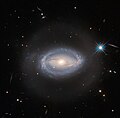
Size of this JPG preview of this TIF file: 610 × 599 pixels. Other resolutions: 244 × 240 pixels | 488 × 480 pixels | 782 × 768 pixels | 1,042 × 1,024 pixels | 1,559 × 1,532 pixels.
Original file (1,559 × 1,532 pixels, file size: 13.7 MB, MIME type: image/tiff)
| This is a file from the Wikimedia Commons. Information from its description page there is shown below. Commons is a freely licensed media file repository. You can help. |
Summary
| DescriptionEverything, in one place, all at once (potw2313a).tiff |
English: This luminous Picture of the Week shows Z 229-15 — imaged here in beautiful detail by the NASA/ESA Hubble Space Telescope — a celestial object that lies about 390 million light-years from Earth in the constellation Lyra. Z 229-15 is one of those interesting celestial objects that, should you choose to research it, you will find defined as several different things: sometimes as an active galactic nucleus (an AGN); sometimes as a quasar; and sometimes as a Seyfert galaxy. Which of these is Z 229-15 really? The answer is that it is all of these things all at once, because these three definitions have significant overlap. AGNs and quasars are both described in detail in the Hubble Word Bank, but in essence an AGN is a small region at the heart of certain galaxies (called active galaxies) that is far brighter than just the galaxy’s stars would be. The extra luminosity is due to the presence of a supermassive black hole at the galaxy’s core. Material sucked into a black hole actually doesn’t fall directly into it, but instead is drawn into a swirling disc, from where it is inexorably tugged towards the black hole. This disc of matter gets so hot that it releases a large amount of energy across the electromagnetic spectrum, and that’s what makes AGNs appear so bright. Quasars are a particular type of AGN; they are typically both extremely bright and extremely distant from Earth — several hundred million light-years is considered nearby for a quasar, making Z 229-15 positively local. Often an AGN is so bright that the rest of the galaxy cannot be seen, but Seyfert galaxies are active galaxies that host very bright AGNs (quasars) while the rest of the galaxy is still observable. So Z 229-15 is a Seyfert galaxy that contains a quasar, and that, by definition, hosts an AGN. Classification in astronomy can be a challenge![Image Description: A spiral galaxy. It has two almost-straight arms coming from the left and right of the core that meet a starry ring around the galaxy’s edge. The ring is bluish in colour, and the core is golden and shining. A faint halo of light also surrounds the galaxy. There is one bright star with many diffraction spikes, and a few small stars all around on a black background.] |
| Date | 27 March 2023 (upload date) |
| Source | Everything, in one place, all at once |
| Author | ESA/Hubble & NASA, A. Barth, R. Mushotzky |
| Other versions |
|
Licensing
| ESA/Hubble images, videos and web texts are released by the ESA under the Creative Commons Attribution 4.0 International license and may on a non-exclusive basis be reproduced without fee provided they are clearly and visibly credited. Detailed conditions are below; see the ESA copyright statement for full information. For images created by NASA or on the hubblesite.org website, or for ESA/Hubble images on the esahubble.org site before 2009, use the {{PD-Hubble}} tag.
Conditions:
Notes:
|
This file is licensed under the Creative Commons Attribution 4.0 International license.
Attribution: ESA/Hubble
- You are free:
- to share – to copy, distribute and transmit the work
- to remix – to adapt the work
- Under the following conditions:
- attribution – You must give appropriate credit, provide a link to the license, and indicate if changes were made. You may do so in any reasonable manner, but not in any way that suggests the licensor endorses you or your use.
Captions
Add a one-line explanation of what this file represents
image/tiff
File history
Click on a date/time to view the file as it appeared at that time.
| Date/Time | Thumbnail | Dimensions | User | Comment | |
|---|---|---|---|---|---|
| current | 21:43, 16 April 2023 |  | 1,559 × 1,532 (13.7 MB) | OptimusPrimeBot | #Spacemedia - Upload of https://esahubble.org/media/archives/images/original/potw2313a.tif via Commons:Spacemedia |
File usage
The following 2 pages use this file:
Metadata
This file contains additional information, probably added from the digital camera or scanner used to create or digitize it.
If the file has been modified from its original state, some details may not fully reflect the modified file.
| Width | 1,559 px |
|---|---|
| Height | 1,532 px |
| Bits per component |
|
| Compression scheme | Uncompressed |
| Pixel composition | RGB |
| Image data location | 27,714 |
| Orientation | Normal |
| Number of components | 3 |
| Number of rows per strip | 1,532 |
| Bytes per compressed strip | 14,330,328 |
| Horizontal resolution | 25.4 dpi |
| Vertical resolution | 25.4 dpi |
| Data arrangement | chunky format |
| Software used | Adobe Photoshop 24.2 (Windows) |
| File change date and time | 15:34, 19 March 2023 |
| Color space | Uncalibrated |


